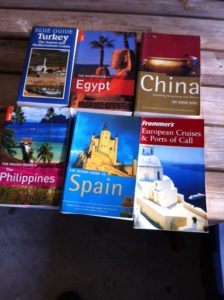I’m in the process of cleaning out the rest of our possessions from our house in upstate New York to complete our move to Tucson, Arizona.
Our house in Tucson is maybe half the size of our house in New York, and therein lies a problem: what to do about the hundreds of books that we no longer have room for and can’t afford to move anyway?
The problem is particularly acute with one genre of books that dominate my old office: travel guidebooks.
To say that I have a sizable collection of them would be a bit of an understatement. They date back to my earliest trips abroad in the 1970’s and continued proliferating in the decades since, reaching a crescendo in the early 1990’s just before the Internet began turning print guidebooks into dinosaurs.
Still, being a baby boomer addicted to print, I almost always bought a guidebook before any major trip, and if I was writing a guidebook myself, I would buy up every other guidebook on the market to see what the competition was up to.
Thus I have dozens of guidebooks on California — adding to the dozen or so I’ve written or co-authored myself — plus another dozen on the Dominican Republic and a like number on Alaska, all of which I’ve produced numerous editions of myself.
Why Keep an Old Guidebook?
But these guidebooks are now all out of date and obsolete. No one wants them (but me). And I can’t even give them away, at least to anyone — including libraries — that I’ve asked.
Why would I want to keep a 40-year-old guidebook to Kenya, a 30-year-old guidebook to China, a 20-year-old guidebook to the California coast, or a ten-year-old guidebook to the Dominican Republic?
Professionally, many still contain information that’s useful — not about hotels and restaurants, many of which have long since bit the dust — but about the history and culture of a nation or state.
They also provide a snapshot into what Kenya, or India, or China, or Fiji, or Brazil, or Greece were like decades ago.
And most of all, they remind me of the trips I took with them in hand. They were my friends and traveling companions as I made my way around the world.
Sometimes, like any traveling companion, they steered me in the wrong direction. But more often they guided me to places that I would never have found otherwise, and gave me insights into the often exotic cultures I was visiting.
Having written a number of these “dinosaurs” myself, I know how much work goes into them, often for comparatively little financial reward. (I once calculated my pay for my first California guidebook at something like five cents an hour.)
Taking them to the recycling center seems like a sacrilege. But in this case, there appear to be no other options.
And so this week I have to say goodbye to many of my old friends from Rough Guides, Lonely Planet, Frommer’s, Fodor’s, Insight, Eyewitness, Michelin, and a host of lesser-known publishers.
Guidebooks, you’ve served me well.
But, as the rather crass saying goes, it’s time to move on.
Which reminds me: as soon as this move is complete, I need to buy some Arizona guidebooks…













5 Responses to The Agony of Old Guidebook Disposal